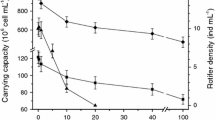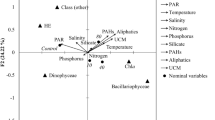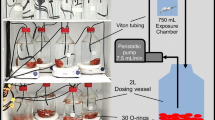Abstract
Polycyclic aromatic hydrocarbons (PAHs), which are major components of crude oil, are responsible in large part for the toxicity of crude oil to phytoplankton. This study addressed the following question. Can reliable predictions of the aquatic toxicity of crude oil, a multi-component mixture, be described from toxicity data on individual PAH compounds? Naphthalene, the most abundant PAH compound, and benzo(a)pyrene, a highly toxic PAH compound, were selected as model compounds to quantify toxicity of crude oil on two phytoplankton species, Ditylum brightwellii and Heterocapsa triquetra, by analyzing the effects of different concentrations of these PAHs on growth rate. EC50 values suggested that the diatom D. brightwellii was more vulnerable to both toxicants than the dinoflagellate H. triquetra. However, a previous study, which investigated the impact of crude oil on the same two species, had opposite results. The differences in response from these phytoplankton species to naphthalene and benzo(a)pyrene toxicity compared to their response to crude oil suggest that they may not be solely used as surrogates to assess crude oil toxicity on phytoplankton.


Similar content being viewed by others

References
Arfsten DP, Schaeffer DJ, Mulveny DC (1996) The effects of near ultraviolet radiation on the toxic effects of polycyclic aromatic hydrocarbons in animals and plants: a review. Ecotoxicol Environ Saf 33(1):1–24
Bopp SK, Lettieri T (2007) Gene regulation in the marine diatom Thalassiosira pseudonana upon exposure to polycyclic aromatic hydrocarbons (PAHs). Gene 396(2):293–302
Brain P, Cousens R (2006) An equation to describe dose responses where there is stimulation of growth at low doses. Weed Res 29(2):93–96
Djomo JE, Dauta A, Ferrier V, Narbonne JF, Monkiedje A, Njine T, Garrigues P (2004) Toxic effects of some major polyaromatic hydrocarbons found in crude oil and aquatic sediments on Scenedesmus subspicatus. Water Res 38(7):1817–1821
Geyer H, Viswanathan R, Freitag D, Korte F (1981) Relationship between water solubility of organic chemicals and their bioaccumulation by the alga Chlorella. Chemosphere 10(11):1307–1313
Hutchinson TC, Hellebust JA, Mackay D, Tarn D, Kauss P (1979) Relationship of hydrocarbon solubility to toxicity in algae and cellular membrane effects. In: International oil spill conference. vol 1. American Petroleum Institute, pp 541–547
Hylland K (2006) Polycyclic aromatic hydrocarbon (PAH) ecotoxicology in marine ecosystems. J Toxicol Environ Health Part A 69(1–2):109–123
Jiang Y, Wu Z, Han X, Zhang L, Wang X (2002) Toxicity of polycyclic aromatic hydrocarbons (PAHs) to marine algae. Mar Sci 26(1):46–50
Kowalewska G (1999) Phytoplankton—the main factor responsible for transport of polynuclear aromatic hydrocarbons from water to sediments in the southern Baltic ecosystem. ICES J Mar Sci 56:219
Kustenko NG (1981) Effect of low oil concentrations on spermatogonangia and auxosporas in three marine diatom species. Oceanology 21:263–265
Landrum P, Giesy J, Oris J, Allred P (1987) Photoinduced toxicity of polycyclic aromatic hydrocarbons to aquatic organisms. Oil in freshwater: chemistry, biology, countermeasure technology. Pergamon Press, Elmsford, NY
Okay O, Tüfekçi V, Donkin P (2002) Acute and chronic toxicity of pyrene to the unicellular marine alga Phaeodactylum tricornutum. Bull Environ Contam Toxicol 68(4):600–605
Othman HB, Leboulanger C, Le Floc’h E, Mabrouk HH, Hlaili AS (2012) Toxicity of benz [a] anthracene and fluoranthene to marine phytoplankton in culture: does cell size really matter? J Hazard Mater
Ozhan K, Miles MS, Gao H, Bargu S (in review) Relative phytoplankton growth responses to physically- and chemically-dispersed South Louisiana Sweet crude oil. Environ Monit Assess
Ritz C, Streibig JC (2005) Bioassay analysis using R. J Stat Softw 12(5):1–22
Sargian P, Mas S, Pelletier E (2007) Multiple stressors on an Antarctic microplankton assemblage: water soluble crude oil and enhanced UVBR level at Ushuaia (Argentina). Polar Biol 30(7):829–841
Skei J, Larsson P, Rosenberg R, Jonsson P, Olsson M, Broman D (2000) Eutrophication and contaminants in aquatic ecosystems. Ambio 29(4):184–194
Sprague J (1970) Measurement of pollutant toxicity to fish. II. Utilizing and applying bioassay results. Water Res 4(1):3–32
Wang L, Zheng B, Meng W (2008) Photo-induced toxicity of four polycyclic aromatic hydrocarbons, singly and in combination, to the marine diatom Phaeodactylum tricornutum. Ecotoxicol Environ Saf 71(2):465–472
Witt G (2002) Occurrence and transport of polycyclic aromatic hydrocarbons in the water bodies of the Baltic Sea. Mar Chem 79(2):49–66
Zukunft PF. (2010) Data, analysis, and findings (2010) http://www.restorethegulf.gov/release/2010/12/16/data-analysis-and-findings. Accessed 06/21/2013
Author information
Authors and Affiliations
Corresponding author
Rights and permissions
About this article
Cite this article
Ozhan, K., Bargu, S. Can Crude Oil Toxicity on Phytoplankton Be Predicted Based on Toxicity Data on Benzo(a)Pyrene and Naphthalene?. Bull Environ Contam Toxicol 92, 225–230 (2014). https://doi.org/10.1007/s00128-013-1181-6
Received:
Accepted:
Published:
Issue Date:
DOI: https://doi.org/10.1007/s00128-013-1181-6



